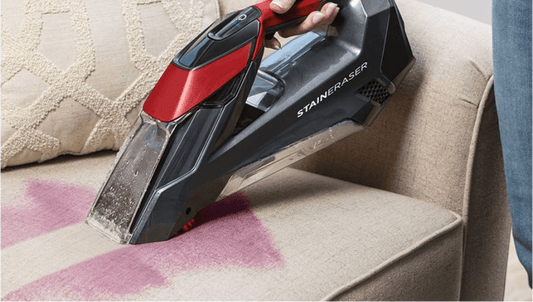Key Takeaways
- Neoprene car seat material requires specific cleaning methods for oil stains—acting within 24 hours dramatically increases your chances of complete removal.
- Dish soap solutions break down fresh oil stains effectively without damaging the neoprene material's integrity or colour.
- Baking soda works as a powerful oil absorber by pulling greasy residue from deep within neoprene fibres.
- For stubborn stains, isopropyl alcohol provides extra cleaning power but should always be spot-tested first to prevent damage.
- Regular vacuuming with professional-grade equipment like Ordiniq's Handheld Wired Car Vacuum Cleaner prevents debris accumulation that carries oils onto neoprene surfaces.
Oil Stains on Neoprene: Why They're Tricky & How to Act Fast
Oil and neoprene don't mix well. When that dreaded grease stain appears on your neoprene car seat covers, quick action makes all the difference between a permanent mark and a successful cleanup. Neoprene, the same synthetic rubber material used in wetsuits, features a unique closed-cell structure that repels water but unfortunately can trap oil within its surface.
Unlike fabric seats that simply absorb stains, neoprene's rubber-like properties create a different challenge. The oil doesn't just sit on top; it begins bonding with the material almost immediately. This is why many store-bought carpet sprays with oxygen-based stain removers often fail completely. They're simply not formulated to break the bond between oil and synthetic rubber.
The good news? With the right approach, even day-old oil stains can be successfully removed. Let's explore the most effective methods that actually work on neoprene's unique surface.
Pro Tip: Before attempting any cleaning method, always blot (don't rub) excess oil from the neoprene surface using clean paper towels or microfibre cloths. Rubbing spreads the stain and pushes oil deeper into the material.
|
Ordiniq Handheld Car Vacuum: Drive Clean, Drive Fresh Join 10,000+ Drivers Who Keep Their Cars Spotless Why Ordiniq’s Vacuum Is Essential
What Customers Say ★★★★★"I keep this light weight vacuum cleaner in our car and handy to clean the mess created by little one. The size is small but powerful enough to clean the car seat. It also has accessories to allow to clean the small gap and corner. Definitely will buy another piece for another car. Good value too." - Connie Try It Risk-Free for 30 Days Experience spotless car interiors with zero worries. If it doesn't transform your daily commute within 30 days, we'll refund your purchase—no questions asked. FREE BONUSES: 1-Year Extended Warranty + FREE Shipping Get Ordiniq's Handheld Wired Car Vacuum Cleaner Today! *Ordiniq also offers AutoPump and a Tyre Repair Kit —great extras to keep in your boot for added peace of mind. |
Method 1: Dish Soap Solution for Fresh Oil Stains

Dish soap's grease-cutting surfactants break down fresh oil stains within 24 hours without damaging neoprene's structure or colour.
Dish soap is specifically formulated to break down grease and oil, making it your first line of defence against fresh neoprene stains.
Its gentle yet effective surfactants cut through oil without damaging the neoprene's structure or colour. This method works particularly well on stains that are less than 24 hours old, when the oil hasn't fully bonded with the material.
What You'll Need
- Dawn dish soap or similar grease-cutting dish detergent
- Warm (not hot) water
- Clean microfibre cloths or soft bristle brush
- Spray bottle
- Clean water for rinsing
Step-by-Step Cleaning Process
Start by mixing one tablespoon of dish soap with two cups of warm water in a spray bottle, shaking gently to create a solution. Spray the mixture directly onto the oil stain, ensuring it's completely covered but not soaking wet.
Allow the solution to sit for 3–5 minutes, giving the soap time to penetrate and break down the oil molecules. This dwell time is crucial for the surfactants to work effectively against the grease.
Next, use a clean microfibre cloth to gently work the solution into the stain using small circular motions. For more stubborn stains, a soft bristle brush can provide extra agitation without damaging the neoprene. The key is patience rather than pressure; let the soap do the chemical work rather than scrubbing aggressively.
After treating the stain, dampen a fresh cloth with clean water and thoroughly remove all soap residue. Any remaining soap can attract new dirt and potentially damage the neoprene over time.
Finally, blot the area dry with a clean towel and allow it to air dry completely before using the seat. Multiple applications may be necessary for complete removal of deeper stains.
When This Method Works Best
The dish soap method shines when dealing with fresh oil stains; those that haven't had time to fully penetrate and bond with the neoprene. Food oils, makeup, hand lotion, and even minor automotive fluid stains respond well to this treatment when caught within the first 24 hours.
If you're dealing with a spill that just happened, this should be your go-to first approach before trying stronger methods.
Method 2: Baking Soda Absorption Technique

Baking soda's fine powder structure creates a massive surface area that physically attracts and holds oil molecules whilst its alkaline nature helps break down stubborn grease.
When dish soap alone isn't quite cutting it, baking soda provides powerful absorption properties that can draw oil out from deeper within the neoprene material.
This method works through both physical and chemical processes. The fine powder creates a large surface area that physically attracts and holds oil molecules whilst its slightly alkaline nature helps break down stubborn grease.
Materials Required
For this method, you'll need baking soda (at least 1/2 cup for larger stains), a soft-bristled brush or old toothbrush, clean microfibre cloths, and warm water.
Optional but helpful additions include a plastic scraper card for removing dried baking soda and a vacuum with brush attachment for final cleanup. The beauty of this method lies in using common household items that are gentle on your neoprene material whilst tough on oil stains.
The 4-Step Cleaning Procedure
Begin by blotting any excess oil from the surface using paper towels or a clean cloth; never rub as this spreads the stain.
Once you've removed as much surface oil as possible, generously sprinkle baking soda over the entire stained area, creating a layer approximately 6mm thick. The powder should completely cover the stain with some overlap onto the clean surrounding area to prevent the oil from spreading outward during treatment.
Allow the baking soda to sit undisturbed for at least 6–8 hours, or ideally overnight. During this time, it works to draw the oil up and out of the neoprene. You may notice the powder changing colour as it absorbs the oil—this is a good sign that the process is working.
After the waiting period, use a soft brush to gently loosen the powder, then vacuum it away completely. For stubborn residue, a slightly damp cloth can help remove any remaining baking soda without reintroducing moisture to the stain.
Ideal Situations for Using Baking Soda
The baking soda method excels with older oil stains that have had time to set into the neoprene, typically those that are 1–3 days old. It's particularly effective for thicker oils like cooking oil, motor oil, and heavy cosmetics that contain significant oil components.
This technique also works well as a follow-up to the dish soap method when dealing with especially stubborn stains, as it can pull out residual oil that soap alone couldn't break down. For maximum effectiveness, apply baking soda to completely dry neoprene; any moisture will diminish its absorptive capabilities.
Method 3: Rubbing Alcohol for Stubborn Oil Stains

Isopropyl alcohol dissolves oil molecules that have deeply bonded with neoprene's synthetic rubber structure, though requiring careful application to prevent material damage.
When gentler methods have failed, isopropyl alcohol (rubbing alcohol) provides a stronger solution for persistent oil stains on neoprene.
This solvent-based approach dissolves oil molecules that have deeply bonded with the synthetic rubber structure of neoprene. Whilst effective, alcohol is the more aggressive end of cleaning options and should be used with appropriate caution.
How It Works & Precaution
Rubbing alcohol works differently than soap or baking soda—rather than lifting or absorbing the oil, it actually dissolves it, breaking down the molecular structure that keeps the stain attached to your neoprene. This dissolving action makes it particularly effective for stains that have set in over time, where the oil has had days or weeks to bond with the material.
The effectiveness of this method depends significantly on the concentration of alcohol used. For neoprene seats, 70% isopropyl alcohol provides the best balance between cleaning power and material safety. Higher concentrations (91% or 99%) can be too harsh and may potentially damage the neoprene or its colouring over time, especially with repeated applications.
Ventilation is crucial when using this method. Always work in a well-ventilated area with windows open or doors ajar to prevent the buildup of alcohol fumes, which can be both unpleasant and potentially hazardous in enclosed spaces like a car interior.
This is especially important during summer months when higher temperatures can increase evaporation rates.
Always test rubbing alcohol on an inconspicuous area of your neoprene seat first. Some coloured neoprene may experience slight fading with alcohol treatment. Wait 5–10 minutes after your test to ensure no discolouration or texture changes occur before proceeding to the stain.
Supplies Needed
- 70% isopropyl alcohol (rubbing alcohol)
- Small spray bottle or cotton balls for application
- Clean white microfibre cloths
- Dish soap solution (as described in Method 1)
- Clean water for rinsing
- Protective gloves (optional but recommended)
Safe Application Steps
Begin by dampening a clean white cloth with rubbing alcohol; it should be wet but not dripping. Gently dab the stained area, working from the outside edges inward to prevent spreading the oil.
Never pour alcohol directly onto neoprene as this can oversaturate and potentially damage the material. Instead, controlled application through a dampened cloth allows better regulation of the amount of alcohol contacting your seat.
Allow the alcohol to work for 30–60 seconds, then blot with a fresh dry cloth to absorb the dissolved oil. You may notice the stain transferring to your cleaning cloth, this is a sign the process is working.
For larger or more stubborn stains, you may need to repeat this process 2–3 times, always using a clean section of cloth for each application to avoid redepositing oil.
After the alcohol treatment has removed the visible stain, follow up with the dish soap method described earlier. This neutralises any remaining alcohol and removes any lingering oil residue.
Complete the process with a clean water rinse using a damp (not wet) cloth to remove all cleaning agents. Allow your neoprene seat to air dry completely before use.
When to Use This Stronger Solution
Reserve the alcohol method for stubborn oil stains that have resisted both dish soap and baking soda treatments. It's particularly effective on older stains (one week or more) that have had significant time to bond with the neoprene material.
This approach also works well for petroleum-based oils like motor oil or mechanical greases that typically resist water-based cleaners.
If you're dealing with a high-value vehicle with premium neoprene covers or limited edition seats, consider consulting professional detailers before attempting the alcohol method yourself.
The risk of damage, whilst small with proper technique, may not be worth taking on especially valuable or irreplaceable neoprene surfaces.
Protect Your Investment Through Proactive Maintenance

Ordiniq's Handheld Wired Car Vacuum Cleaner delivers the preventive cleaning capability that stops oil contamination before expensive stain removal or seat replacement becomes necessary.
Preventing Costly Neoprene Replacement
Neoprene car seat covers represent significant investments, with quality sets costing £200–500 depending on vehicle model and coverage. Each aggressive stain removal session, particularly those requiring alcohol treatment, degrades the synthetic rubber structure slightly, accumulating damage that eventually necessitates premature replacement.
At Ordiniq, our Handheld Wired Car Vacuum Cleaner eliminates this degradation cycle by removing the debris particles that carry oil residues before contamination bonds with neoprene surfaces.
Unlimited Power for Thorough Protection
Battery-powered vacuums force rushed cleaning through their 9–30 minute runtime limitations, missing the methodical debris extraction that effective oil prevention demands.
Our wired design delivers consistent professional-grade suction throughout complete interior maintenance sessions, extracting particles from textured neoprene valleys, reaching between seat seams where debris accumulates, and addressing floor areas where contaminants collect before transfer.
The unlimited 12V-powered operation transforms prevention from compromise into comprehensive protection.
Complete Automotive Care Integration
Beyond interior maintenance, our ecosystem addresses every aspect of vehicle ownership.
- The AutoPump maintains optimal tyre pressure that prevents the uneven wear requiring premature replacement.
- The Tyre Repair Kit handles roadside emergencies where clean stain treatment conditions don't exist.
This integrated approach protects your entire automotive investment through professional-grade equipment rather than consumer-grade compromises.
Proven Reliability Across the UK
Over 10,000 UK drivers trust our products for daily vehicle maintenance, validating the performance claims through real-world use rather than marketing promises.
Experience our Handheld Wired Car Vacuum Cleaner risk-free through the 30-day money-back guarantee that lets you verify its preventive capabilities firsthand.
The included 1-year extended warranty and complimentary free shipping demonstrate our commitment to long-term value rather than short-term sales.
| Get the Handheld Wired Car Vacuum Cleaner today! |
Frequently Asked Questions (FAQs)
Can I use bleach on neoprene car seats?
Never use bleach on neoprene car seats. Bleach breaks down the synthetic rubber structure of neoprene, causing permanent damage including discolouration, weakening of the material, and potentially complete deterioration of the seat cover.
Even diluted bleach solutions can cause irreversible harm to neoprene's unique molecular structure. Instead of bleach, stick with the gentle cleaning methods outlined above that preserve neoprene's integrity whilst still effectively removing stains.
How long should I wait before treating an oil stain on neoprene?
Treat oil stains on neoprene immediately when possible, ideally within the first hour after the spill occurs. The longer an oil stain remains untreated, the more deeply it bonds with neoprene's synthetic rubber structure.
Fresh stains (under 24 hours old) can often be completely removed with just dish soap, whilst those left for days may require the full progression through all three cleaning methods described above.
If immediate treatment isn't possible, at minimum blot excess oil with paper towels and apply a light dusting of baking soda until you can perform a complete cleaning.
Will cleaning products damage the colour of my neoprene seats?
Colour safety varies by cleaning product and neoprene quality.
Dish soap solutions are generally safe for all neoprene colours when used as directed, as they work through gentle surfactant action rather than harsh chemical processes. Baking soda is colourfast and won't fade or alter neoprene pigments, making it the safest option for coloured neoprene. Rubbing alcohol may cause slight fading on some brightly coloured or dyed neoprene, particularly on cheaper seat covers where dye quality proves inferior.
Commercial degreasers often contain harsh solvents that can strip colour; so, avoid them unless they are specifically formulated for neoprene.
Can I use a steam cleaner on neoprene car seats?
Steam cleaning is not recommended for neoprene car seats. The high heat from steam cleaners can damage neoprene's cellular structure, potentially causing the material to warp, stretch or degrade.
Whilst neoprene is water-resistant, it's not designed to withstand the combination of high temperature and moisture that steam cleaners deliver. The closed-cell structure that makes neoprene water-resistant also makes it vulnerable to heat-induced expansion and contraction that can compromise material integrity.
How does regular vacuuming with the Ordiniq Handheld Wired Car Vacuum prevent oil stains on neoprene seats?
Regular vacuuming with professional-grade equipment like Ordiniq's Handheld Wired Car Vacuum Cleaner prevents oil stains through comprehensive debris removal that eliminates the particles carrying oil residues onto neoprene surfaces.
Most oil contamination doesn't come from direct spills but from accumulated particles—road dust containing petroleum residues, food crumbs harbouring cooking oils, clothing fibres transferring body oils and cosmetics, and dead skin cells containing natural oils.
These particles settle onto seats and gradually transfer oils through contact and pressure, eventually creating visible staining. The Ordiniq vacuum's continuous power delivers consistent professional-grade suction throughout complete cleaning sessions.
*Note: Pricing and/or product availability mentioned in this post are subject to change. Please check the retailer's website for current pricing and stock information before making a purchase.




